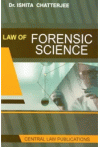- Author(s): Ishita Chatterjee
- Publisher: Central Law Publications
- Edition: 1 Ed Rp 2019
- ISBN 13 9789384961329
- Approx. Pages 874 + contents
- Format Paperback
- Approx. Product Size 24 x 16 cms
- Delivery Time 3-5 working days (within Kerala & South India) (Others 7-9 days)
- Shipping Charge Extra (see Shopping Cart)
............................................................................................
Description
The main use of forensic science is for purposes of law enforcement to investigate crimes such as murder, theft, or fraud, forensic scientists are also involved in investigating accidents such as train or plane crashes to establish if they were accidental or a result of foul play. The techniques developed by forensic science are also used by the army to analyze the possibility of the presence of chemical weapons, high explosives or to test for propellant stabilizers.The Daubert decision upheld that there are certain important differences between the quest for truth in the laboratory and the quest for truth in the courtroom. Scientific conclusions are not exclusive and are subject to perpetual revision. On the other hand, it is the duty of the judiciary to resolvè disputes finally and speedily. In criminal cases accused parties are convicted on the basis of testimony from forensic science experts, therefore much depends upon the reliability of evidence presented before Court of Law. It is highly recommended that law enforcement officials and the members of society must assure that forensic techniques are reliable. Thus before forensic evidence is admitted in the Court, the techniques to find out that evidence must be properly studied and their accuracy must be verified. Scientific evidence is not only valuable to a successful criminal prosecution, but it may also be crucial in the eyes of many jurors. This book on Law of Forensic Science strives to make the technology of the modern crime laboratory clear and comprehensible to the non-scientist. The nature of physical evidence is defined, and the limitations that technology and current knowledge impose on its individualization and characterization are examined. By combining case stories with applicable technology, this book endeavors to capture the pulse and fervor of forensic science investigations. A major portion of the text centers on discussions of the common items of physical evidence encountered at crime scenes. These chapters include descriptions of forensic analysis, as well as updated techniques for the proper collection and preservation of evidence at crime scenes. Particular attention is paid to the meaning and role of probability in interpreting the evidential significance of scientifically evaluated evidence.
........................................................................................
Table of Contents
Chapter 1. Forensic Science
Chapter 2. Forensic Science in Justice Delivery System
Chapter 3. Medical Opinion - Evidentiary Valu
Chapter 4. Medical Negligence and Consumer Protection Act
Chapter 5. Human Rights and Medicine
Chapter 6. Medico-Legal Aspects of Injuries
Chapter 7. Medical Legal Aspects of Wound
Chapter 8. Forensic: Defining Death
Chapter 9. Post-Mortem Examination
Chapter 10. Introduction
Chapter 11. Test-Tube Techiques
Chapter 12. Slaughtering Eve he Hidden Gendercide
Chapter 13. Mental Health
Chapter 14. DNA Legislation
Chapter 15. Neuroscience
............................................................................................
Author Details
Dr, Ishita Chatterjee
LL.M., Ph.D. (Allahabad University) Assistant Professor, ICFAI Law School, ICFAI University, Tripura

